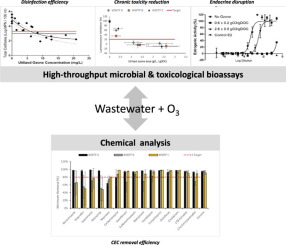Chemical Engineering Journal ( IF 13.3 ) Pub Date : 2018-04-11 , DOI: 10.1016/j.cej.2018.04.037 Deniz Nasuhoglu , Siavash Isazadeh , Paul Westlund , Sarah Neamatallah , Viviane Yargeau

|
Municipal wastewater treatment plants (WWTP) effluents are primary sources of pathogenic microorganisms and contaminants of emerging concern (CECs) released into the aquatic environment. Main concerns regarding these pollutants include transmission of waterborne diseases to humans and toxic and endocrine disrupting effects on aquatic organisms. In the coming years, WWTPs are expected to invest billions of dollars in upgrades to meet new regulatory requirements for wastewater from Environment Canada. For this reason, we investigated the performance of ozone when the technology is used for disinfection to overcome multiple risk factors such as disinfection, CEC removal, endocrine activity and toxicity for real effluents collected from three WWTPs. Two secondary effluents required mean specific ozone doses for disinfection of 0.25 and 1.04 gO3/gDOC whereas the advanced primary effluent required 1.52 gO3/gDOC to achieve a total coliform target disinfection criteria of 1000 MPN/100 ml (equivalent to 200 MPN/100 ml E. coli). At ozone doses for disinfection, CECs with high reactivity with ozone were removed at levels greater than the target CEC removal of 80% for all WWTP effluents. For the secondary effluents, ozone doses above 2.6 ± 0.6 gO3/gDOC were required to satisfy the target removal for the recalcitrant CECs. Within the disinfection ozone dose range, estrogenic activity was reduced by more than 98% and androgenic activity was removed by more than 68%, while the anti-estrogenic activity remained unchanged. Lastly, based on the luminescence inhibition of V. fischeri, ozone doses for disinfection produced secondary effluents exhibiting less than 20% inhibition, thus falling under the hazard classification “no acute/chronic toxicity”.
中文翻译:

臭氧氧化消毒过程中废水处理厂废水的化学,微生物和毒理学评估
市政废水处理厂(WWTP)的废水是致病微生物和释放到水生环境中的新兴污染物(CEC)的主要来源。有关这些污染物的主要问题包括水传播疾病对人类的传播以及对水生生物的有毒和内分泌干扰作用。在未来几年中,污水处理厂将投资数十亿美元进行升级,以满足加拿大环境部对废水的新法规要求。因此,我们调查了使用该技术进行消毒以克服多种危险因素(如消毒,CEC去除,内分泌活性和从三个污水处理厂收集的真实废水的毒性)时臭氧的性能。两种二次流出物的平均臭氧消毒剂量分别为0.25和1.04 gO3 / gDOC,而先进的主要出水需要1.52 gO 3 / gDOC才能达到1000 MPN / 100 ml(相当于200 MPN / 100 ml大肠杆菌)的大肠菌目标消毒标准。在用于消毒的臭氧剂量下,与臭氧具有高反应活性的CEC的去除水平要高于所有WWTP废水中目标CEC去除80%的水平。对于次要废水,需要达到2.6±0.6 gO 3 / gDOC以上的臭氧剂量才能满足顽固CEC的目标去除要求。在消毒臭氧剂量范围内,雌激素活性降低了98%以上,雄激素活性去除了68%以上,而抗雌激素活性保持不变。最后,基于对费氏弧菌的发光抑制, 用于消毒的臭氧剂量产生的次级污水显示出不到20%的抑制作用,因此属于“无急性/慢性毒性”危险类别。











































 京公网安备 11010802027423号
京公网安备 11010802027423号